Key Concepts in Human Resource Development: An Overview
VerifiedAdded on 2022/10/09
|6
|1471
|35
Homework Assignment
AI Summary
This assignment provides a comprehensive overview of key concepts within Human Resource Development (HRD). It defines and explains various terms including ROI, demographic factors, educational statistics, ethical practices, data analysis, and megatrends. The document further explores outcomes, people-oriented planning, outputs, intra-educational diagnosis, re-culturing, and school mapping. Each concept is clearly defined with relevant examples, offering a robust understanding of the HRD field. The assignment incorporates a detailed bibliography, supporting the information presented with credible sources. Overall, it serves as a valuable resource for anyone seeking a foundational understanding of HRD principles and practices.
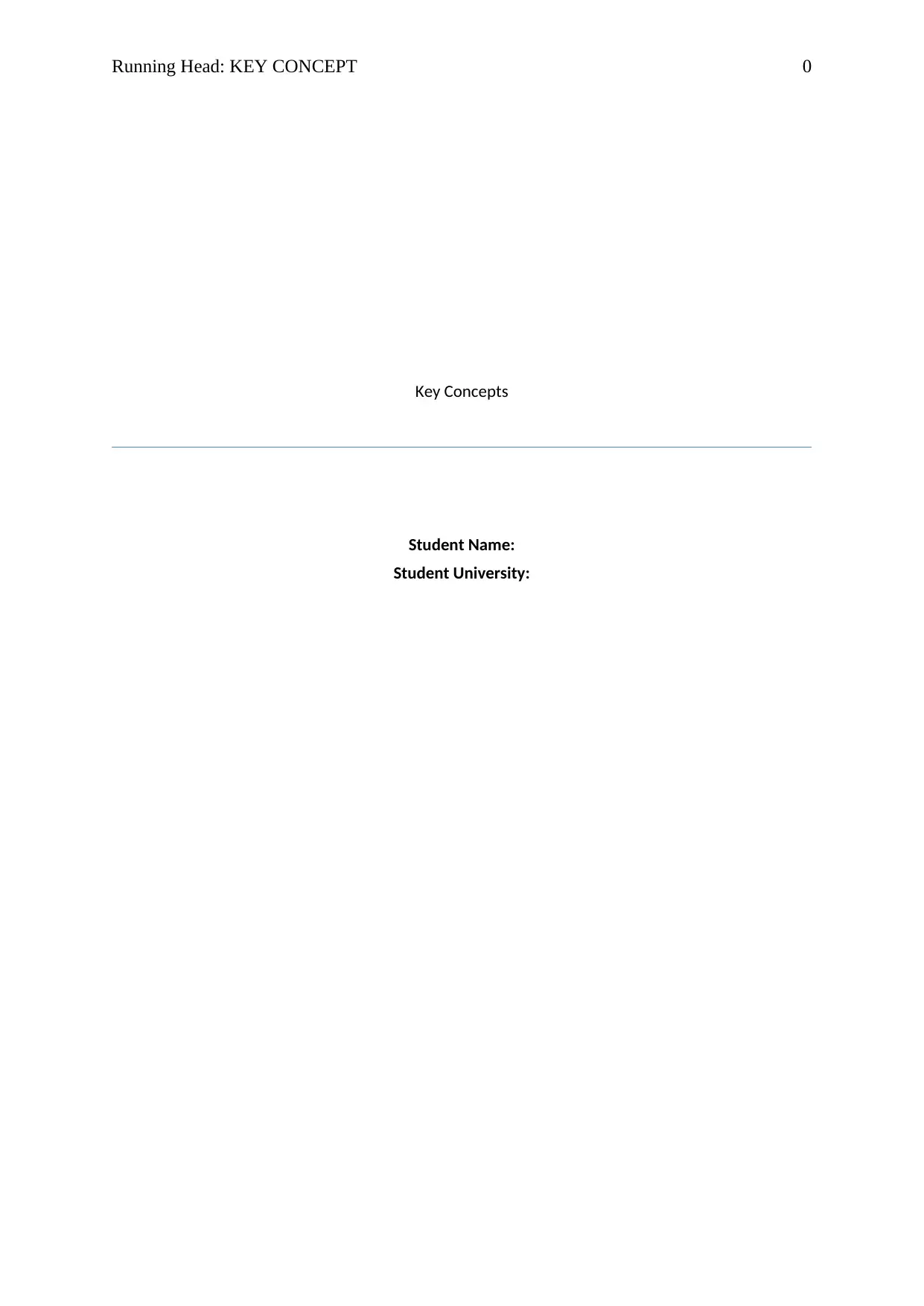
Running Head: KEY CONCEPT 0
Key Concepts
Student Name:
Student University:
Key Concepts
Student Name:
Student University:
Paraphrase This Document
Need a fresh take? Get an instant paraphrase of this document with our AI Paraphraser
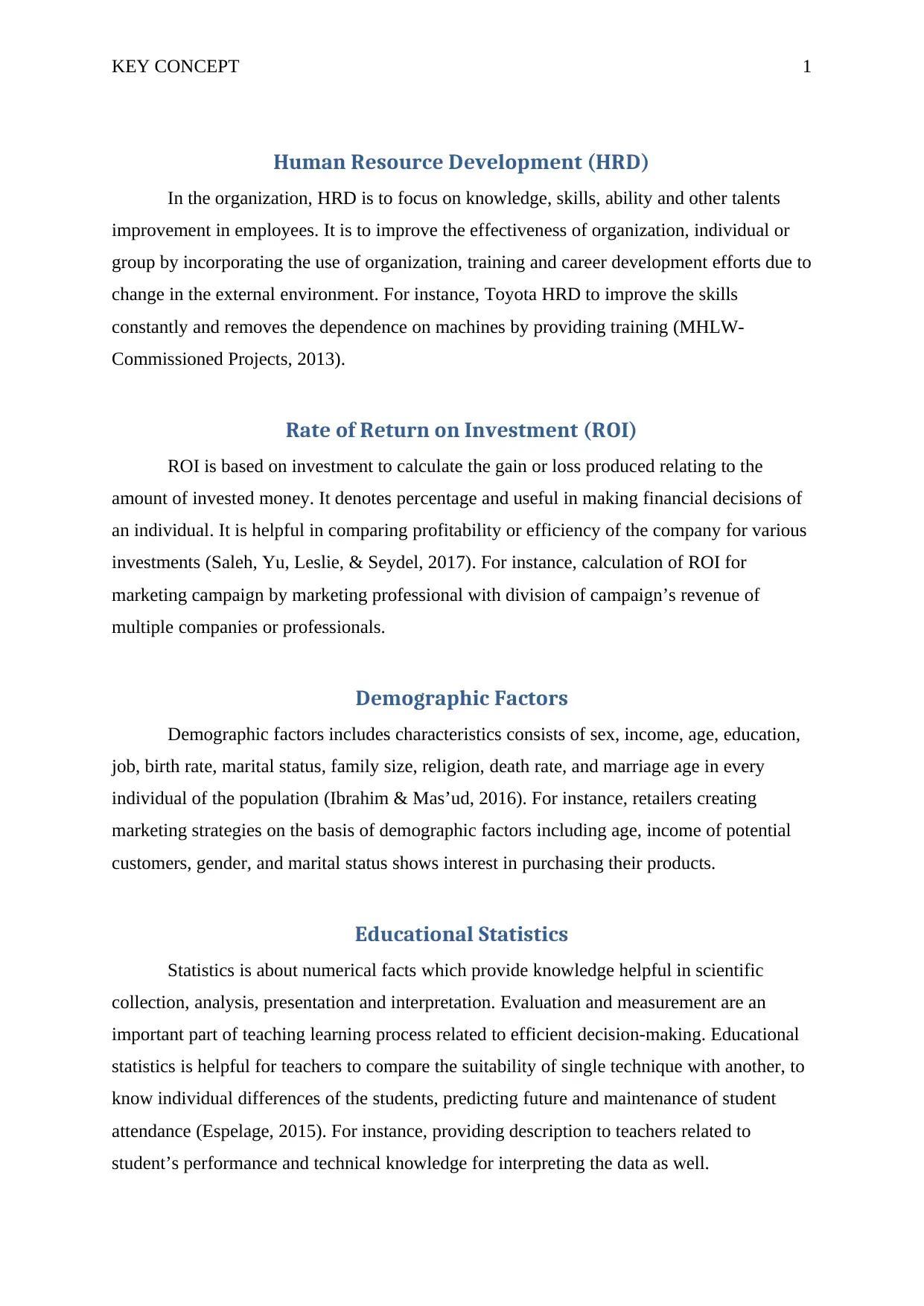
KEY CONCEPT 1
Human Resource Development (HRD)
In the organization, HRD is to focus on knowledge, skills, ability and other talents
improvement in employees. It is to improve the effectiveness of organization, individual or
group by incorporating the use of organization, training and career development efforts due to
change in the external environment. For instance, Toyota HRD to improve the skills
constantly and removes the dependence on machines by providing training (MHLW-
Commissioned Projects, 2013).
Rate of Return on Investment (ROI)
ROI is based on investment to calculate the gain or loss produced relating to the
amount of invested money. It denotes percentage and useful in making financial decisions of
an individual. It is helpful in comparing profitability or efficiency of the company for various
investments (Saleh, Yu, Leslie, & Seydel, 2017). For instance, calculation of ROI for
marketing campaign by marketing professional with division of campaign’s revenue of
multiple companies or professionals.
Demographic Factors
Demographic factors includes characteristics consists of sex, income, age, education,
job, birth rate, marital status, family size, religion, death rate, and marriage age in every
individual of the population (Ibrahim & Mas’ud, 2016). For instance, retailers creating
marketing strategies on the basis of demographic factors including age, income of potential
customers, gender, and marital status shows interest in purchasing their products.
Educational Statistics
Statistics is about numerical facts which provide knowledge helpful in scientific
collection, analysis, presentation and interpretation. Evaluation and measurement are an
important part of teaching learning process related to efficient decision-making. Educational
statistics is helpful for teachers to compare the suitability of single technique with another, to
know individual differences of the students, predicting future and maintenance of student
attendance (Espelage, 2015). For instance, providing description to teachers related to
student’s performance and technical knowledge for interpreting the data as well.
Human Resource Development (HRD)
In the organization, HRD is to focus on knowledge, skills, ability and other talents
improvement in employees. It is to improve the effectiveness of organization, individual or
group by incorporating the use of organization, training and career development efforts due to
change in the external environment. For instance, Toyota HRD to improve the skills
constantly and removes the dependence on machines by providing training (MHLW-
Commissioned Projects, 2013).
Rate of Return on Investment (ROI)
ROI is based on investment to calculate the gain or loss produced relating to the
amount of invested money. It denotes percentage and useful in making financial decisions of
an individual. It is helpful in comparing profitability or efficiency of the company for various
investments (Saleh, Yu, Leslie, & Seydel, 2017). For instance, calculation of ROI for
marketing campaign by marketing professional with division of campaign’s revenue of
multiple companies or professionals.
Demographic Factors
Demographic factors includes characteristics consists of sex, income, age, education,
job, birth rate, marital status, family size, religion, death rate, and marriage age in every
individual of the population (Ibrahim & Mas’ud, 2016). For instance, retailers creating
marketing strategies on the basis of demographic factors including age, income of potential
customers, gender, and marital status shows interest in purchasing their products.
Educational Statistics
Statistics is about numerical facts which provide knowledge helpful in scientific
collection, analysis, presentation and interpretation. Evaluation and measurement are an
important part of teaching learning process related to efficient decision-making. Educational
statistics is helpful for teachers to compare the suitability of single technique with another, to
know individual differences of the students, predicting future and maintenance of student
attendance (Espelage, 2015). For instance, providing description to teachers related to
student’s performance and technical knowledge for interpreting the data as well.
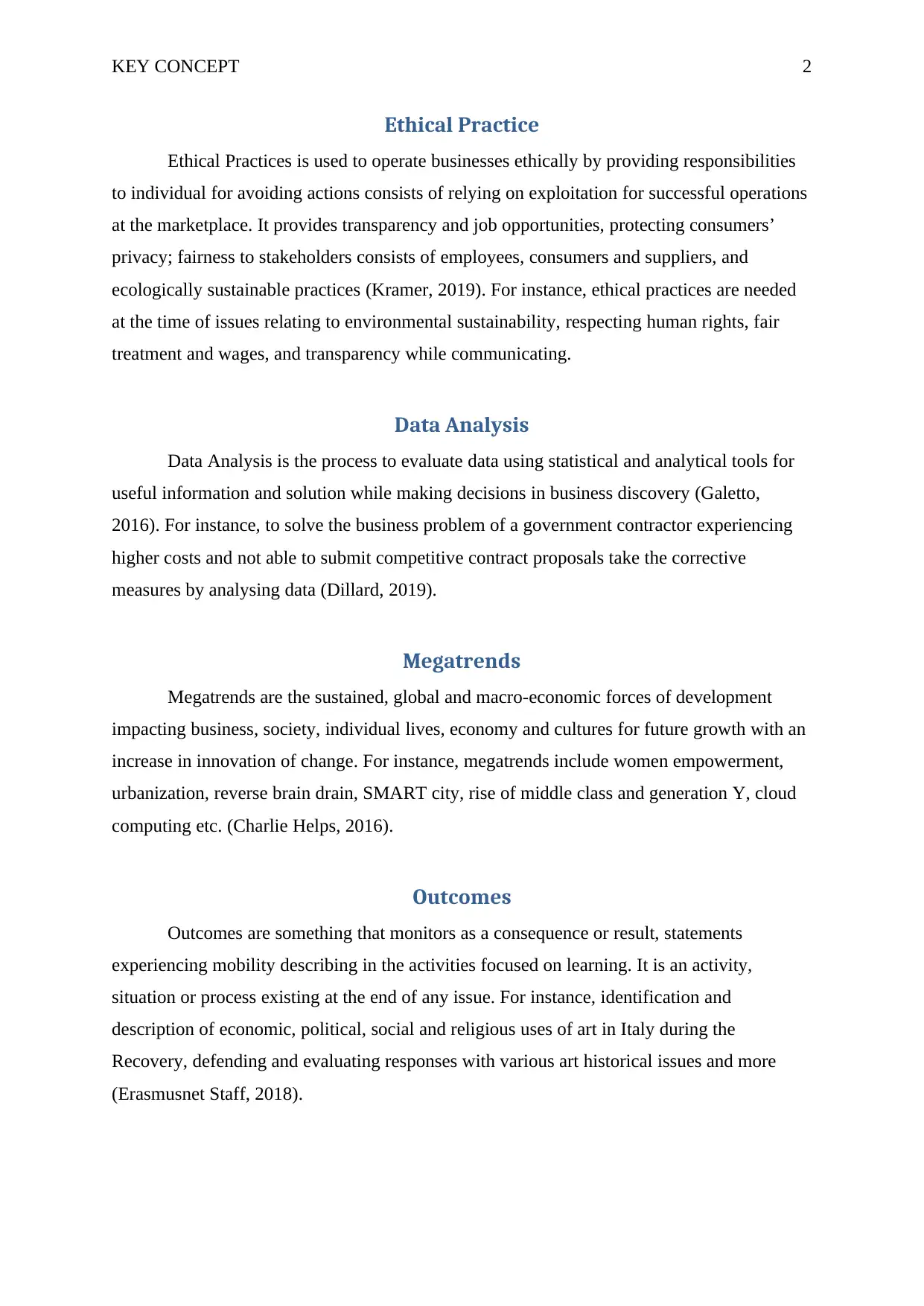
KEY CONCEPT 2
Ethical Practice
Ethical Practices is used to operate businesses ethically by providing responsibilities
to individual for avoiding actions consists of relying on exploitation for successful operations
at the marketplace. It provides transparency and job opportunities, protecting consumers’
privacy; fairness to stakeholders consists of employees, consumers and suppliers, and
ecologically sustainable practices (Kramer, 2019). For instance, ethical practices are needed
at the time of issues relating to environmental sustainability, respecting human rights, fair
treatment and wages, and transparency while communicating.
Data Analysis
Data Analysis is the process to evaluate data using statistical and analytical tools for
useful information and solution while making decisions in business discovery (Galetto,
2016). For instance, to solve the business problem of a government contractor experiencing
higher costs and not able to submit competitive contract proposals take the corrective
measures by analysing data (Dillard, 2019).
Megatrends
Megatrends are the sustained, global and macro-economic forces of development
impacting business, society, individual lives, economy and cultures for future growth with an
increase in innovation of change. For instance, megatrends include women empowerment,
urbanization, reverse brain drain, SMART city, rise of middle class and generation Y, cloud
computing etc. (Charlie Helps, 2016).
Outcomes
Outcomes are something that monitors as a consequence or result, statements
experiencing mobility describing in the activities focused on learning. It is an activity,
situation or process existing at the end of any issue. For instance, identification and
description of economic, political, social and religious uses of art in Italy during the
Recovery, defending and evaluating responses with various art historical issues and more
(Erasmusnet Staff, 2018).
Ethical Practice
Ethical Practices is used to operate businesses ethically by providing responsibilities
to individual for avoiding actions consists of relying on exploitation for successful operations
at the marketplace. It provides transparency and job opportunities, protecting consumers’
privacy; fairness to stakeholders consists of employees, consumers and suppliers, and
ecologically sustainable practices (Kramer, 2019). For instance, ethical practices are needed
at the time of issues relating to environmental sustainability, respecting human rights, fair
treatment and wages, and transparency while communicating.
Data Analysis
Data Analysis is the process to evaluate data using statistical and analytical tools for
useful information and solution while making decisions in business discovery (Galetto,
2016). For instance, to solve the business problem of a government contractor experiencing
higher costs and not able to submit competitive contract proposals take the corrective
measures by analysing data (Dillard, 2019).
Megatrends
Megatrends are the sustained, global and macro-economic forces of development
impacting business, society, individual lives, economy and cultures for future growth with an
increase in innovation of change. For instance, megatrends include women empowerment,
urbanization, reverse brain drain, SMART city, rise of middle class and generation Y, cloud
computing etc. (Charlie Helps, 2016).
Outcomes
Outcomes are something that monitors as a consequence or result, statements
experiencing mobility describing in the activities focused on learning. It is an activity,
situation or process existing at the end of any issue. For instance, identification and
description of economic, political, social and religious uses of art in Italy during the
Recovery, defending and evaluating responses with various art historical issues and more
(Erasmusnet Staff, 2018).
⊘ This is a preview!⊘
Do you want full access?
Subscribe today to unlock all pages.

Trusted by 1+ million students worldwide
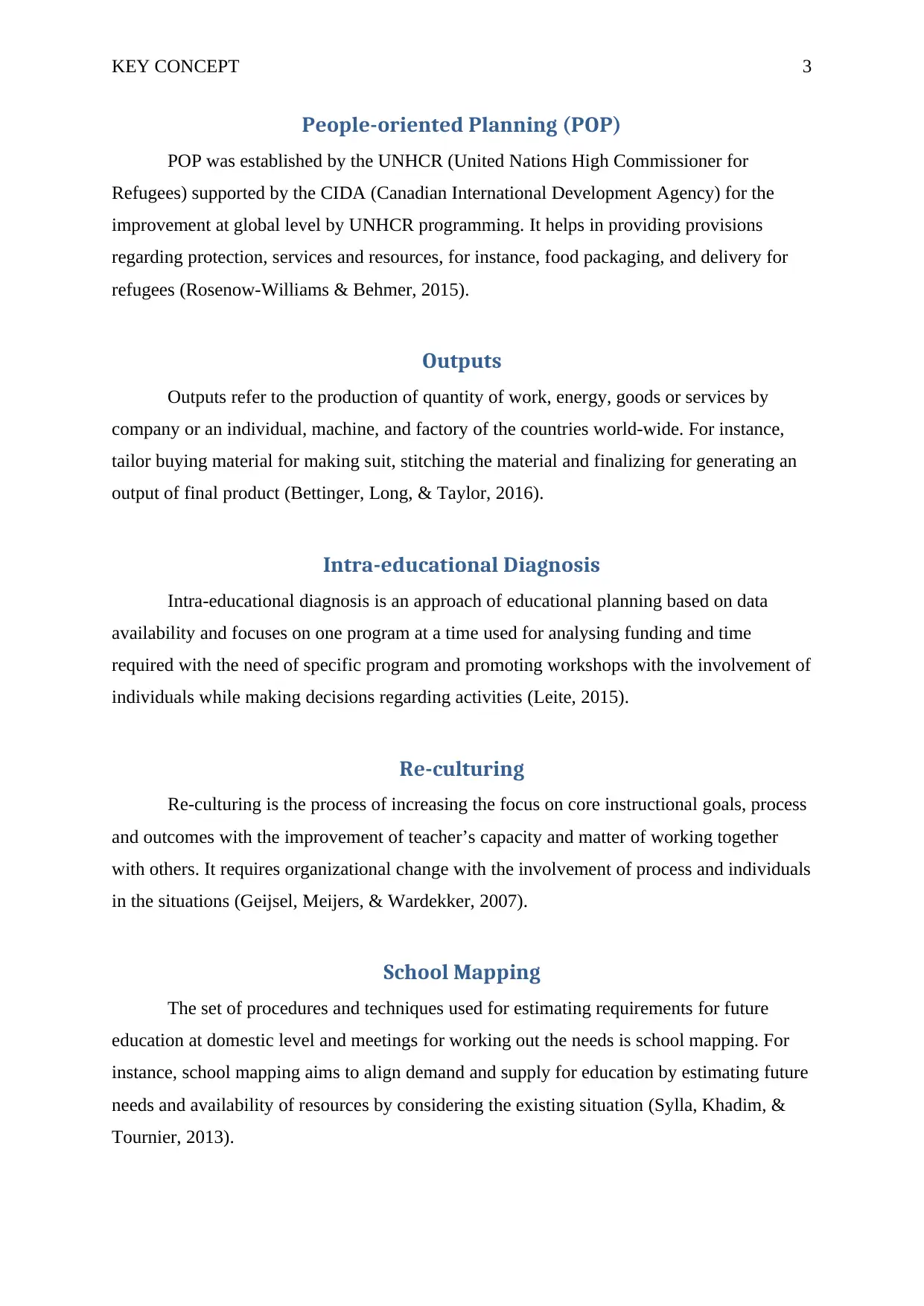
KEY CONCEPT 3
People-oriented Planning (POP)
POP was established by the UNHCR (United Nations High Commissioner for
Refugees) supported by the CIDA (Canadian International Development Agency) for the
improvement at global level by UNHCR programming. It helps in providing provisions
regarding protection, services and resources, for instance, food packaging, and delivery for
refugees (Rosenow-Williams & Behmer, 2015).
Outputs
Outputs refer to the production of quantity of work, energy, goods or services by
company or an individual, machine, and factory of the countries world-wide. For instance,
tailor buying material for making suit, stitching the material and finalizing for generating an
output of final product (Bettinger, Long, & Taylor, 2016).
Intra-educational Diagnosis
Intra-educational diagnosis is an approach of educational planning based on data
availability and focuses on one program at a time used for analysing funding and time
required with the need of specific program and promoting workshops with the involvement of
individuals while making decisions regarding activities (Leite, 2015).
Re-culturing
Re-culturing is the process of increasing the focus on core instructional goals, process
and outcomes with the improvement of teacher’s capacity and matter of working together
with others. It requires organizational change with the involvement of process and individuals
in the situations (Geijsel, Meijers, & Wardekker, 2007).
School Mapping
The set of procedures and techniques used for estimating requirements for future
education at domestic level and meetings for working out the needs is school mapping. For
instance, school mapping aims to align demand and supply for education by estimating future
needs and availability of resources by considering the existing situation (Sylla, Khadim, &
Tournier, 2013).
People-oriented Planning (POP)
POP was established by the UNHCR (United Nations High Commissioner for
Refugees) supported by the CIDA (Canadian International Development Agency) for the
improvement at global level by UNHCR programming. It helps in providing provisions
regarding protection, services and resources, for instance, food packaging, and delivery for
refugees (Rosenow-Williams & Behmer, 2015).
Outputs
Outputs refer to the production of quantity of work, energy, goods or services by
company or an individual, machine, and factory of the countries world-wide. For instance,
tailor buying material for making suit, stitching the material and finalizing for generating an
output of final product (Bettinger, Long, & Taylor, 2016).
Intra-educational Diagnosis
Intra-educational diagnosis is an approach of educational planning based on data
availability and focuses on one program at a time used for analysing funding and time
required with the need of specific program and promoting workshops with the involvement of
individuals while making decisions regarding activities (Leite, 2015).
Re-culturing
Re-culturing is the process of increasing the focus on core instructional goals, process
and outcomes with the improvement of teacher’s capacity and matter of working together
with others. It requires organizational change with the involvement of process and individuals
in the situations (Geijsel, Meijers, & Wardekker, 2007).
School Mapping
The set of procedures and techniques used for estimating requirements for future
education at domestic level and meetings for working out the needs is school mapping. For
instance, school mapping aims to align demand and supply for education by estimating future
needs and availability of resources by considering the existing situation (Sylla, Khadim, &
Tournier, 2013).
Paraphrase This Document
Need a fresh take? Get an instant paraphrase of this document with our AI Paraphraser
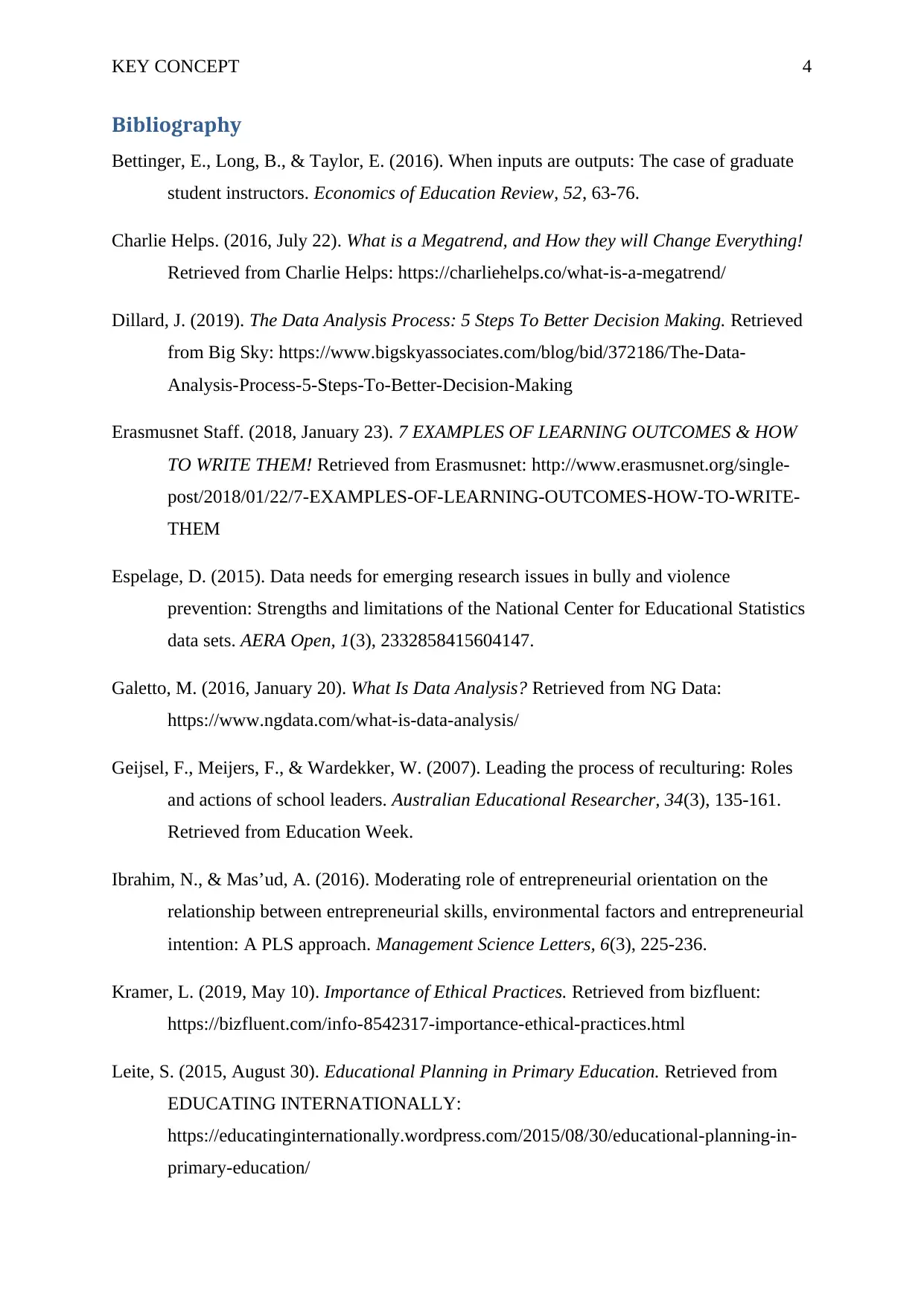
KEY CONCEPT 4
Bibliography
Bettinger, E., Long, B., & Taylor, E. (2016). When inputs are outputs: The case of graduate
student instructors. Economics of Education Review, 52, 63-76.
Charlie Helps. (2016, July 22). What is a Megatrend, and How they will Change Everything!
Retrieved from Charlie Helps: https://charliehelps.co/what-is-a-megatrend/
Dillard, J. (2019). The Data Analysis Process: 5 Steps To Better Decision Making. Retrieved
from Big Sky: https://www.bigskyassociates.com/blog/bid/372186/The-Data-
Analysis-Process-5-Steps-To-Better-Decision-Making
Erasmusnet Staff. (2018, January 23). 7 EXAMPLES OF LEARNING OUTCOMES & HOW
TO WRITE THEM! Retrieved from Erasmusnet: http://www.erasmusnet.org/single-
post/2018/01/22/7-EXAMPLES-OF-LEARNING-OUTCOMES-HOW-TO-WRITE-
THEM
Espelage, D. (2015). Data needs for emerging research issues in bully and violence
prevention: Strengths and limitations of the National Center for Educational Statistics
data sets. AERA Open, 1(3), 2332858415604147.
Galetto, M. (2016, January 20). What Is Data Analysis? Retrieved from NG Data:
https://www.ngdata.com/what-is-data-analysis/
Geijsel, F., Meijers, F., & Wardekker, W. (2007). Leading the process of reculturing: Roles
and actions of school leaders. Australian Educational Researcher, 34(3), 135-161.
Retrieved from Education Week.
Ibrahim, N., & Mas’ud, A. (2016). Moderating role of entrepreneurial orientation on the
relationship between entrepreneurial skills, environmental factors and entrepreneurial
intention: A PLS approach. Management Science Letters, 6(3), 225-236.
Kramer, L. (2019, May 10). Importance of Ethical Practices. Retrieved from bizfluent:
https://bizfluent.com/info-8542317-importance-ethical-practices.html
Leite, S. (2015, August 30). Educational Planning in Primary Education. Retrieved from
EDUCATING INTERNATIONALLY:
https://educatinginternationally.wordpress.com/2015/08/30/educational-planning-in-
primary-education/
Bibliography
Bettinger, E., Long, B., & Taylor, E. (2016). When inputs are outputs: The case of graduate
student instructors. Economics of Education Review, 52, 63-76.
Charlie Helps. (2016, July 22). What is a Megatrend, and How they will Change Everything!
Retrieved from Charlie Helps: https://charliehelps.co/what-is-a-megatrend/
Dillard, J. (2019). The Data Analysis Process: 5 Steps To Better Decision Making. Retrieved
from Big Sky: https://www.bigskyassociates.com/blog/bid/372186/The-Data-
Analysis-Process-5-Steps-To-Better-Decision-Making
Erasmusnet Staff. (2018, January 23). 7 EXAMPLES OF LEARNING OUTCOMES & HOW
TO WRITE THEM! Retrieved from Erasmusnet: http://www.erasmusnet.org/single-
post/2018/01/22/7-EXAMPLES-OF-LEARNING-OUTCOMES-HOW-TO-WRITE-
THEM
Espelage, D. (2015). Data needs for emerging research issues in bully and violence
prevention: Strengths and limitations of the National Center for Educational Statistics
data sets. AERA Open, 1(3), 2332858415604147.
Galetto, M. (2016, January 20). What Is Data Analysis? Retrieved from NG Data:
https://www.ngdata.com/what-is-data-analysis/
Geijsel, F., Meijers, F., & Wardekker, W. (2007). Leading the process of reculturing: Roles
and actions of school leaders. Australian Educational Researcher, 34(3), 135-161.
Retrieved from Education Week.
Ibrahim, N., & Mas’ud, A. (2016). Moderating role of entrepreneurial orientation on the
relationship between entrepreneurial skills, environmental factors and entrepreneurial
intention: A PLS approach. Management Science Letters, 6(3), 225-236.
Kramer, L. (2019, May 10). Importance of Ethical Practices. Retrieved from bizfluent:
https://bizfluent.com/info-8542317-importance-ethical-practices.html
Leite, S. (2015, August 30). Educational Planning in Primary Education. Retrieved from
EDUCATING INTERNATIONALLY:
https://educatinginternationally.wordpress.com/2015/08/30/educational-planning-in-
primary-education/
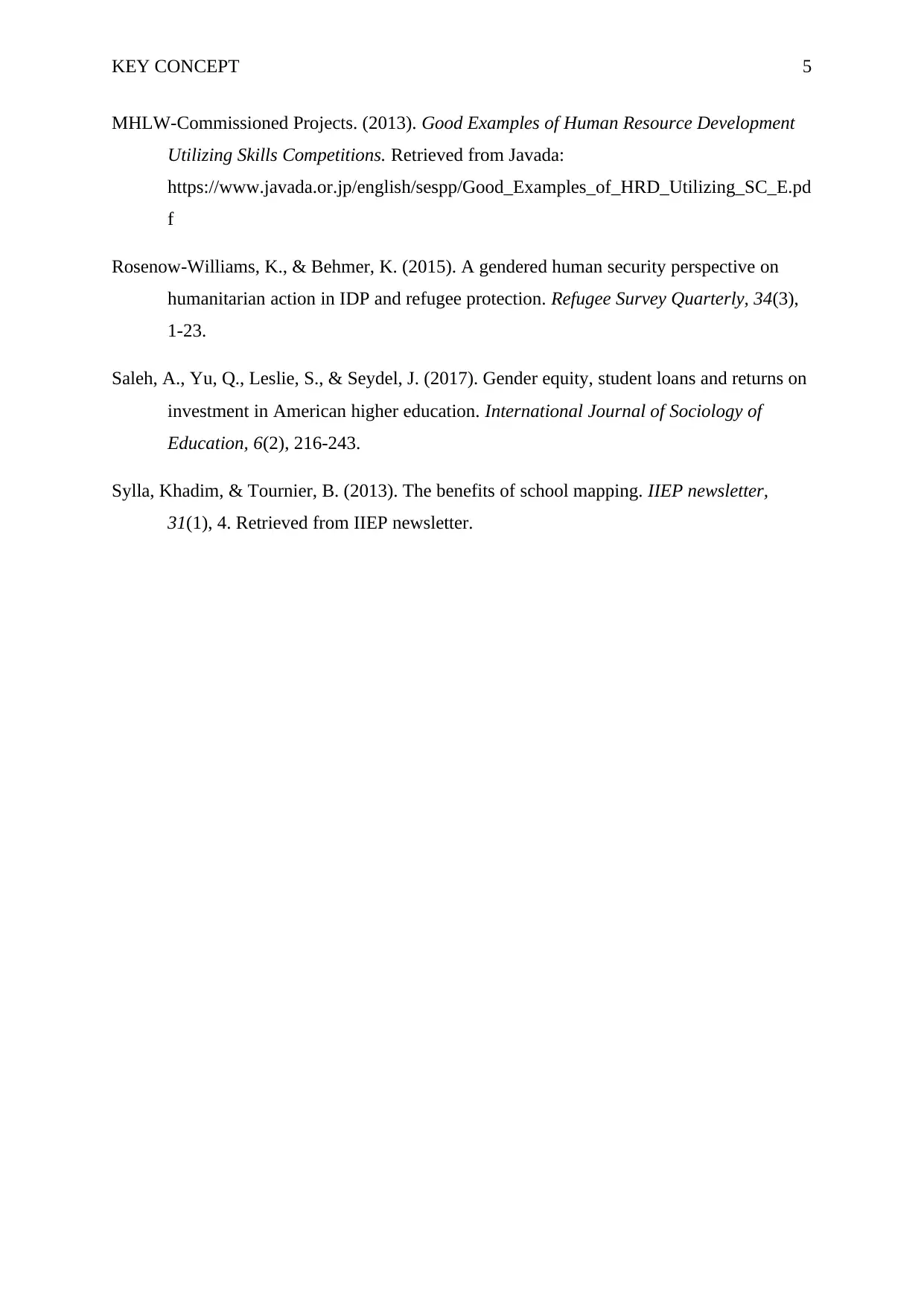
KEY CONCEPT 5
MHLW-Commissioned Projects. (2013). Good Examples of Human Resource Development
Utilizing Skills Competitions. Retrieved from Javada:
https://www.javada.or.jp/english/sespp/Good_Examples_of_HRD_Utilizing_SC_E.pd
f
Rosenow-Williams, K., & Behmer, K. (2015). A gendered human security perspective on
humanitarian action in IDP and refugee protection. Refugee Survey Quarterly, 34(3),
1-23.
Saleh, A., Yu, Q., Leslie, S., & Seydel, J. (2017). Gender equity, student loans and returns on
investment in American higher education. International Journal of Sociology of
Education, 6(2), 216-243.
Sylla, Khadim, & Tournier, B. (2013). The benefits of school mapping. IIEP newsletter,
31(1), 4. Retrieved from IIEP newsletter.
MHLW-Commissioned Projects. (2013). Good Examples of Human Resource Development
Utilizing Skills Competitions. Retrieved from Javada:
https://www.javada.or.jp/english/sespp/Good_Examples_of_HRD_Utilizing_SC_E.pd
f
Rosenow-Williams, K., & Behmer, K. (2015). A gendered human security perspective on
humanitarian action in IDP and refugee protection. Refugee Survey Quarterly, 34(3),
1-23.
Saleh, A., Yu, Q., Leslie, S., & Seydel, J. (2017). Gender equity, student loans and returns on
investment in American higher education. International Journal of Sociology of
Education, 6(2), 216-243.
Sylla, Khadim, & Tournier, B. (2013). The benefits of school mapping. IIEP newsletter,
31(1), 4. Retrieved from IIEP newsletter.
⊘ This is a preview!⊘
Do you want full access?
Subscribe today to unlock all pages.

Trusted by 1+ million students worldwide
1 out of 6
Your All-in-One AI-Powered Toolkit for Academic Success.
+13062052269
info@desklib.com
Available 24*7 on WhatsApp / Email
![[object Object]](/_next/static/media/star-bottom.7253800d.svg)
Unlock your academic potential
Copyright © 2020–2025 A2Z Services. All Rights Reserved. Developed and managed by ZUCOL.
